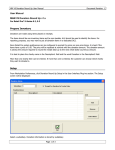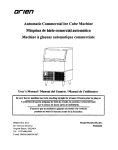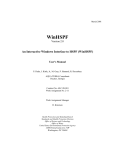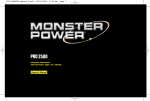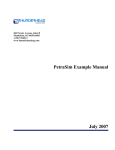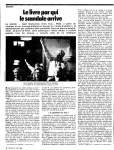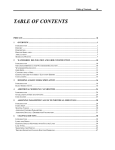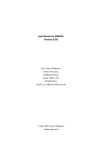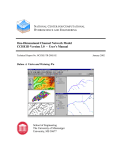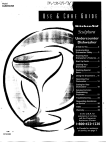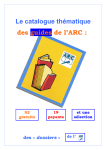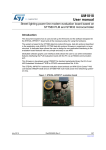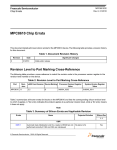Download User Manual - Great Lakes Commission
Transcript
U.S. Army Corps of Engineers Detroit District Clinton River Watershed Model User Manual Prepared by W.F. Baird & Associates Ltd. Madison, Wisconsin May 16, 2005 CLINTON RIVER WATERSHED MODEL USER MANUAL Prepared for: US ARMY CORPS OF ENGINEERS DETROIT DISTRICT CONTRACT # DACW35-01-D-0009/0012 Prepared by: W.F. BAIRD & ASSOCIATES COASTAL ENGINEERS LTD. MADISON, WI MAY 16, 2005 USACE – Detroit District Great Lakes Hydraulics and Hydrology Office Clinton River Watershed Model User Manual Clinton River Watershed Model User Manual For further information please contact James P. Selegean, P.E,PhD.: (313)226-6791 This report was prepared by W.F. Baird & Associates Ltd. for USACE Detroit District. The material in it reflects the judgment of Baird & Associates in light of the information available to them at the time of preparation. Any use which a Third Party makes of this report, or any reliance on decisions to be made based on it, are the responsibility of such Third Parties. Baird & Associates accepts no responsibility for damages, if any, suffered by any Third Party as a result of decisions made or actions based on this report. USACE – Detroit District Great Lakes Hydraulics and Hydrology Office Clinton River Watershed Model User Manual TABLE OF CONTENTS 1.0 INTRODUCTION ...................................................................................... 1 2.0 SWAT....................................................................................................... 1 2.1 System Requirements and Setup...............................................................................................1 2.2 Data Requirements.....................................................................................................................2 2.3 File Setup.....................................................................................................................................4 2.4 SWAT Set Up For Individual Subbasin Tutorial....................................................................4 2.5 Change Land Use Tutorial ......................................................................................................25 2.6 Clinton SWAT Model Calibration Parameters .....................................................................34 2.7 Land Management Practices in SWAT..................................................................................34 2.8 SWAT Output Description ......................................................................................................35 2.9 Future Developments ...............................................................................................................36 3.0 GSSHA................................................................................................... 37 3.1 The Project File (*.prj) ............................................................................................................37 3.2 The Index Map Tables .............................................................................................................39 3.3 GSSHA Land Use Change Tutorial........................................................................................45 3.4 Running GSSHA ......................................................................................................................53 3.5 GSSHA output interpretation .................................................................................................54 4.0 GIS PROJECTS...................................................................................... 55 5.0 REFERENCES ........................................................................................ 56 APPENDIX UM1 - SWAT PEER REVIEWED PUBLICATIONS APPENDIX UM2 - INSTRUCTIONS TO INSTALL MANUAL GRID EDITOR ARCVIEW EXTENSION USACE – Detroit District Great Lakes Hydraulics and Hydrology Office Table of Contents Clinton River Watershed Model User Manual 1.0 INTRODUCTION The following user manual is designed to complement the Clinton River Watershed Sediment Transport Study Report (USACE, 2005) as well as the existing user manuals for the numerical models (SWAT and GSSHA) used in the Clinton River Watershed Modeling System. The following manual gives the users of the Clinton River watershed models some additional information about the set up and execution of the SWAT and GSSHA models as well as certain insight gained through the development of these models for this specific watershed. In addition, the GIS projects set up for the Clinton River Watershed Sediment Transport Study are introduced and explained. Guidance on how to use the SWAT and GSSHA models, where they are applicable, as well as example applications are given in USACE (2005), Sections 4 and 7. 2.0 SWAT In addition to the accompanying report (USACE, 2005), the user has at their disposal several documents pertaining to the SWAT model and AVSWAT interface (Di Luzio, et al., 2001; Neitsch, et al., 2002a; Neitsch, et al., 2002b). It is assumed that the user will utilize these documents as a guide for general SWAT model setup and execution. The SWAT website also provides a list of SWAT peer reviewed publications. This list is included in Appendix UM1. The following sections are designed to present some of the most relevant information for getting started using the Clinton River SWAT model as well as walk the user through some model modifications to ultimately rerun the SWAT model to see the change in results. For this project, the ArcView interface (AVSWAT) was used to set up and run the SWAT model, thus this manual will assume the user is using the same. 2.1 System Requirements and Setup The computer requirements and software setup for the Clinton River watershed SWAT model are similar to those described in Section 2 of the AVSWAT User Guide. The following system requirements are taken directly from the AVSWAT User Guide: The SWAT2000/Arcview Interface requires: • Personal computer using a Pentium I processor or higher, which runs at 166 megahertz or faster • 64 megabytes RAM minimum • Microsoft Windows 95, 98, NT 4.0 or Win2000 operating system with most recent kernel patch* USACE – Detroit District Great Lakes Hydraulics and Hydrology Office 1 Clinton River Watershed Model User Manual • • • • • VGA graphics adapter and monitor. The interface works best when the resolution is set to 800 x 600 or 1024 x 768 pixels, the color palette is set to 8-bit (256 colors) or 16-bit (32768 colors) and the display font size is set to small fonts. 50 megabytes free memory on the hard drive for minimal installation and up to 300 megabytes for a full installation ArcView 3.1 or 3.2 (software) Spatial Analyst 1.1 or later (software) Dialog Developer 3.1 or later (software – included with ArcView) While 50 MB is adequate hard drive space for installing the interface, you may need considerably more space to store the tables generated when the interface processes the map layers.† We have found that a 2 gigabyte hard drive works very well for storing ArcView, the SWAT/ArcView interface, and project maps and tables. Microsoft constantly updates the different versions of windows. This interface was developed with the latest version of Windows and may not run with earlier versions. Patches are available from Microsoft. † The space required to create a SWAT project with the SWAT/ArcView interface depends on the resolution of the maps used. While testing the interface, a 10-meter resolution DEM map layer taking up only 6 MB of space was processed. At one point in the analysis of the map, the interface had filled 350 MB of storage with data. * An important note about the software requirements is that to use the AVSWAT interface the user not only needs ArcView 3.X but also the Spatial Analyst Extension for ArcView, which is a separate cost. Section 2 of the AVSWAT User Guide (Di Luzio, et al., 2001) also provides instructions on how to install the SWAT ArcView interface. The files used for installation can be downloaded directly from the official SWAT website: http://www.brc.tamus.edu/swat/. Order of installation: 1. ArcView 3.x 2. Spatial Analyst 3. AVSWAT 4. BASINS (optional – install if the user would like to use GenScn for output processing) 2.2 Data Requirements The required datasets are described in detail in the AVSWAT User Guide, Section 3. The following is a summary of the datasets needed; in addition, comments are given to further expand upon the requirements of certain datasets: USACE – Detroit District Great Lakes Hydraulics and Hydrology Office 2 Clinton River Watershed Model User Manual Required ArcView Map Themes: • ArcInfo-ArcView GRID—Digital Elevation Model (DEM) • ArcInfo-ArcView GRID or Shape—Land Cover/Land Use – the land cover/land use is reclassified when brought in to AVSWAT, the user should double-check the data table used for reclassification to be sure it corresponds correctly to their dataset • ArcInfo-ArcView GRID or Shape—Soil – AVSWAT is designed to use the NRCS STATSGO soil dataset, though a pre-processor for the more detailed SSURGO soil dataset has been developed at Texas A&M University and can be downloaded at http://lcluc.tamu.edu/ssurgo/; the SWAT model developed for the Clinton River watershed used the STATSGO soil dataset • ArcInfo-ArcView GRID or Shape or Draw Manually—DEM Mask (optional) • ArcInfo-ArcView Shape—Stream Delineation (optional) The GIS datasets used in the Clinton River watershed SWAT model are listed in Table 4.1. It is important to remember that all GIS data sets must have the same projection to use them in AVSWAT. Required ArcView Tables and Text Files: • Subbasin Outlet Location Table (dBase Table) • Watershed Inlet Location Table (dBase Table) • Land Use Look Up Table (dBase or ASCII) –the table developed for the Clinton River watershed SWAT model for use with the NLCD land use dataset is given in Table 2.1. • Soil Look Up Table (dBase or ASCII) • Weather Generator Gage Location Table (dBase) • Precipitation Gage Location Table (dBase) • Precipitation Data Table (dBase or ASCII) • Temperature Gage Location Table (dBase) • Temperature Data Table (dBase or ASCII) • Solar Radiation, Wind Speed, or Relative Humidity Gage Location Table (dBase) • Solar Radiation Data Table (dBase or ASCII) • Wind Speed Data Table (dBase or ASCII) • Relative Humidity Data Table (dBase or ASCII) • Point Discharge Data Table—Annual Loadings (dBase or ASCII) • Point Discharge Data Table—Monthly Loadings (dBase or ASCII) • Point Discharge Data Table—Daily Loadings (dBase or ASCII) • Reservoir Monthly Outflow Data Table (dBase or ASCII) • Reservoir Daily Outflow Data Table (dBase or ASCII) • Potential ET Data Table (dBase or ASCII) USACE – Detroit District Great Lakes Hydraulics and Hydrology Office 3 Clinton River Watershed Model User Manual It should be noted that most of these tables and text files are not necessary to set up a simple SWAT model. Many are used to customize the model for special datasets or measured inputs. Table 2.1: Land use reclassification table for AVSWAT SWAT Land SWAT Land Cover/Plant NLCD NLCD Land Use Category Cover/Plant Type Type Description code 11 Open Water WATR Water 21 Low Intensity Residential URLD Residential-Low Density 22 High Intensity Residential URHD Residential-High Density 23 Commercial/Industrial/Transportation UCOM Commercial 32 Quarries/Strip Mines/Gravel Pits UIDU Industrial 33 Transitional RNGE Range-Grasses 41 Deciduous Forest FRSD Forest-Deciduous 42 Evergreen Forest FRSE Forest-Evergreen 43 Mixed Forest FRST Forest-Mixed 81 Pasture/Hay PAST Pasture 82 Row Crops AGRR Agricultural Land-Row Crops 85 Urban/Recreational Grasses AGRL Agricultural Land-Generic 91 Woody Wetlands WETF Wetlands-Forested 92 Emergent Herbaceous Wetlands WETN Wetlands-Non-Forested 2.3 File Setup All data and model files needed to run the Clinton River SWAT model are included on the accompanying CD. In order to get the model to run properly please follow these instructions: • • • Copy ClintonSWAT folder from the CD to c:\ drive. Copy MI folder from CD to \\AVS2000\AvSwatDB\AllUs\statsgo. Copy gridedit.avx from CD to \\ESRI\AV_GIS30\ARCVIEW\EXT32. After each file or folder is copied, be sure to uncheck Read Only in the properties dialog for each file/folder. If the files are left as “Read Only” the SWAT model will not run properly. In the following tutorials, some folder locations (pathnames) may be different from what the user will have on their computer, depending on what drive the SWAT model was installed. 2.4 SWAT Set Up For Individual Subbasin Tutorial USACE – Detroit District Great Lakes Hydraulics and Hydrology Office 4 Clinton River Watershed Model User Manual The following tutorial shows how to set up the Clinton SWAT model for an individual subbasin by starting with the overall watershed SWAT model (clintonws.swat). The red boxes on the following screen images show where the user needs to click or type; the yellow boxes are to draw the user’s attention (no action is required); and the red numbers indicate the order in which the actions need to occur. Step 1: Copy original SWAT project and save under new project name. 1 2 USACE – Detroit District Great Lakes Hydraulics and Hydrology Office 5 Clinton River Watershed Model User Manual 3 Step 2: When the copy process is finished, click Open Project to open the newly created project. 4 USACE – Detroit District Great Lakes Hydraulics and Hydrology Office 6 Clinton River Watershed Model User Manual 5 Step 3: Open the Watershed view. 6 Step 4: Open the Automatic Delineation dialog box. 7 USACE – Detroit District Great Lakes Hydraulics and Hydrology Office 7 Clinton River Watershed Model User Manual Step 5: To mask the desired subbasin area, click the box next to Focusing watershed area option. Click Manually delineate, though other options are available. Click No when asked to Edit the previous shape of mask area. 8 2 1 9 USACE – Detroit District Great Lakes Hydraulics and Hydrology Office 8 Clinton River Watershed Model User Manual Step 6: Draw a line around the desired subbasin (in the case the Paint Creek subbasin) using the Draw tool. This will create a mask so only the portion of the DEM within this area will be processed – this saves processing time. 10 USACE – Detroit District Great Lakes Hydraulics and Hydrology Office 9 Clinton River Watershed Model User Manual Step 7: Click Apply to process DEM. 11 12 13 USACE – Detroit District Great Lakes Hydraulics and Hydrology Office 10 Clinton River Watershed Model User Manual Step 8: Set threshold area for subbasins and click Apply to create stream network. The smaller the number, the more detailed the stream network generated. 1 2 14 USACE – Detroit District Great Lakes Hydraulics and Hydrology Office 11 Clinton River Watershed Model User Manual Step 9: To determine location for outlet of basin, open the USGS gage shapefile and add an outlet at the gage location. This allows for direct comparison of SWAT output to gage measurements. 15 16 USACE – Detroit District Great Lakes Hydraulics and Hydrology Office 12 Clinton River Watershed Model User Manual Step 10: Select gage location for whole watershed outlet. 17 2 1 18 USACE – Detroit District Great Lakes Hydraulics and Hydrology Office 13 Clinton River Watershed Model User Manual 19 Step 11: After watersheds have been delineated, click Apply to calculate subbasin parameters. 20 Step 12: From the AVSWAT menu, select Land Use and Soil Definition. 21 USACE – Detroit District Great Lakes Hydraulics and Hydrology Office 14 Clinton River Watershed Model User Manual Step 13: Select Land Use layer. 22 2 1 23 2 1 24 2 1 25 USACE – Detroit District Great Lakes Hydraulics and Hydrology Office 15 Clinton River Watershed Model User Manual Step 14: Select land use lookup table and reclassify. 26 2 1 27 2 1 28 USACE – Detroit District Great Lakes Hydraulics and Hydrology Office 16 Clinton River Watershed Model User Manual 2 1 29 30 Step 15: Select soils layer. 31 USACE – Detroit District Great Lakes Hydraulics and Hydrology Office 17 Clinton River Watershed Model User Manual 2 1 32 2 1 33 2 1 34 1 2 35 USACE – Detroit District Great Lakes Hydraulics and Hydrology Office 18 Clinton River Watershed Model User Manual 36 Step 16: Set HRU parameters. 37 USACE – Detroit District Great Lakes Hydraulics and Hydrology Office 19 Clinton River Watershed Model User Manual 2 1 3 4 38 Step 17: Specify climate data. 39 USACE – Detroit District Great Lakes Hydraulics and Hydrology Office 20 Clinton River Watershed Model User Manual 40 2 1 41 42 USACE – Detroit District Great Lakes Hydraulics and Hydrology Office 21 Clinton River Watershed Model User Manual 2 1 43 44 45 USACE – Detroit District Great Lakes Hydraulics and Hydrology Office 22 Clinton River Watershed Model User Manual Step 18: Write input files. 46 47 48 Step 19: Run SWAT simulation. 49 USACE – Detroit District Great Lakes Hydraulics and Hydrology Office 23 Clinton River Watershed Model User Manual 1 2 3 50 51 52 USACE – Detroit District Great Lakes Hydraulics and Hydrology Office 24 Clinton River Watershed Model User Manual 2.5 Change Land Use Tutorial The following tutorial shows how to change the land use in the Clinton SWAT model and see how the watershed reacts to the change. The red boxes on the following screen images show where the user needs to click or type; the yellow boxes are to draw the users attention (no action is required); and the red numbers indicate the order in which the actions need to occur. Step 1: Copy original SWAT project and save under new project name. 53 54 USACE – Detroit District Great Lakes Hydraulics and Hydrology Office 25 Clinton River Watershed Model User Manual 55 Step 2: When the copy process is finished, click Open Project to open the newly created project. 56 USACE – Detroit District Great Lakes Hydraulics and Hydrology Office 26 Clinton River Watershed Model User Manual 57 58 Step 3: Open the “Watershed” view. 59 The next step is to modify the original land use used for the SWAT model or create/import a new land use coverage (e.g., a future land use coverage). For this USACE – Detroit District Great Lakes Hydraulics and Hydrology Office 27 Clinton River Watershed Model User Manual exercise, the SWAT Land Use grid will be modified using an ArcView extension called “Manual Grid Editor”. Refer to Appendix UM2 for instructions on how to install this ArcView extension. Step 4: Make the SWAT Land Use grid active and open the Manual Grid Editor. 2 1 60 Step 5: Select area of land use grid to modify. The Manual Grid Editor allows the user to modify the whole grid or just a portion (using the graphics tools) and to change the selected area to multiple land use values or one single value. 61 USACE – Detroit District Great Lakes Hydraulics and Hydrology Office 28 Clinton River Watershed Model User Manual For this example a polygon will be used to change the land use in the selected area to low intensity residential (grid code = 21). The first click will initiate the polygon, and to complete the polygon, hold down the “Ctrl” key while clicking the final point or double-click on the final point. 2 1 4 5 3 – Draw Polygon 62 USACE – Detroit District Great Lakes Hydraulics and Hydrology Office 29 Clinton River Watershed Model User Manual 63 Step 6: Select newly modified land use grid (“Modified Grid”) for use in SWAT model. USACE – Detroit District Great Lakes Hydraulics and Hydrology Office 30 Clinton River Watershed Model User Manual 64 65 USACE – Detroit District Great Lakes Hydraulics and Hydrology Office 31 Clinton River Watershed Model User Manual 2 1 66 2 1 67 2 1 68 USACE – Detroit District Great Lakes Hydraulics and Hydrology Office 32 Clinton River Watershed Model User Manual 69 2 1 70 2 1 71 2 1 72 USACE – Detroit District Great Lakes Hydraulics and Hydrology Office 33 Clinton River Watershed Model User Manual 1 2 73 Step 7: 2.6 Proceed with SWAT setup and run model. Clinton SWAT Model Calibration Parameters Table 2.2 lists the calibration parameter adjustments used for the entire Clinton River Watershed SWAT model for 1992 land use. Refer to Section 13.3 of the AVSWAT User’s Guide for information regarding the AVSWAT Calibration Tool. Table 2.2 Calibration parameters for Clinton SWAT model. Calibration Parameter CN2 ALPHA_BF ESCO REVAPMN 2.7 Adjustment -4 +0.5 +0.95 +50 Land Management Practices in SWAT • • Tillage operations – refer to Technical Documentation (TD) 20.6 o Tillage operation redistributes residue, nutrients, pesticides and bacteria in the soil profile. o User has the option of varying the curve number in the HRU throughout the year. o From Table 4 in Kirsch, et al. (2002) Transect Survey Residue Assumed SWAT Tillage Practice Conventional (<15% cover) Moldboard plow Other (15% to 30% cover) 2 passes with chisel plow Mulch (>30% cover) 1 pass with chisel plow No-till No-till Filter strips – refer to TD 20.10 USACE – Detroit District Great Lakes Hydraulics and Hydrology Office 34 Clinton River Watershed Model User Manual • • • • 2.8 o Edge-of field filter strips may be defined in an HRU. o Sediment, nutrient, pesticide and bacteria loads in surface runoff are reduced as the surface runoff passes through the filter strip. Riparian buffer areas – refer to Vaché, et al. (2002) o Adjust channel cover factor and channel erodibility factor. Irrigation – refer to TD 21.1 o Irrigation in an HRU may be scheduled by the user or automatically applied by SWAT. o In addition to specifying the timing and application amount, the user must specify the source of irrigation water. Infiltration – refer to TD 22.1 & 22.2 o User can specify fraction of impervious area, fraction of directly connected impervious area and curve number for urban land types. o Hydraulic conductivity can also be altered. o Use Green & Ampt method and sub-daily precipitation to directly model infiltration. Street sweeping in urban areas – refer to TD 22.4.1 o Sweep operations impact build up of solids in the impervious portion of the HRU. o SWAT performs street sweeping operations only when the build up/wash off algorithm is specified for urban loading calculations. o SWAT Output Description Every SWAT simulation generates a number of output files including: • The summary output file (output.std), • The HRU output file (.sbs), • The subbasin output file (.bsb) and • The main channel or reach output file (.rch) These are ASCII text files that can be viewed using any text editor. These files (excluding output.std) can also be imported into ArcView. After the SWAT model is run, a dialog box will appear asking if the user wants to read the ASCII outputs. If “yes” is selected, AVSWAT will create .dbf table files from the ASCII text outputs, import them into the ArcView project and open them. The user then has the option to use the Map-Chart tool under the Reports menu to plot the SWAT results. Chapter 32 of the SWAT User’s Manual (Neitsch, 2002a) explains in detail the primary output files and the information they contain. Descriptions of the most relevant output variables for the Clinton River SWAT model are described below. USACE – Detroit District Great Lakes Hydraulics and Hydrology Office 35 Clinton River Watershed Model User Manual Subbasin Output File (basins.bsb) This file contains summary information for each subbasin in the watershed. Variable Name PRECIP Description____________________________________________ Total amount of precipitation falling on the subbasin during a time step (mm H2O). SURQ Surface runoff contribution to streamflow during a time step (mm H2O). GW_Q Groundwater contribution to streamflow (mm). Water from the shallow aquifer that returns to the reach during a time step. WYLD Water yield (mm H2O). The net amount of water that leaves the subbasin and contributes to streamflow in the reach during a time step. SYLD Sediment yield (metric tons/ha). Sediment from the subbasin that is transported into the reach during a time step. Main Channel Output File (basins.rch) This file contains summary information for each routing reach in the watershed. Variable Name FLOW_IN Description____________________________________________ Average daily streamflow into reach during a time step (m3/s). FLOW_OUT Average daily streamflow out of reach during a time step (m3/s). SED_IN Sediment transported with water into reach during a time step (metric tons). SED_OUT Sediment transported with water out of reach during a time step (metric tons). SEDCONC Concentration of sediment in reach during a time step (mg/L). 2.9 Future Developments An ArcView 8.x interface for SWAT is currently under development by Francisco Olivera and others at Texas A&M University. It is compatible with the ArcHydro data model, a standard data model for spatial and temporal hydrologic data, thus enabling more integration with other hydrologic and hydraulic models that use the same types of input data. Since ESRI (the developer of the ArcView software) is no longer updating the ArcView 3.x software, there is a general trend away from ArcView 3.X and towards ArcView 8.X (and 9.X). USACE – Detroit District Great Lakes Hydraulics and Hydrology Office 36 Clinton River Watershed Model User Manual 3.0 GSSHA GSSHA is a physically-based, distributed-parameter model that simulates the hydraulic response of watersheds to a given hydrometeorological condition. The major components of the model include: • • • • • • • • • • Precipitation (spatial and temporal variation) Precipitation interception Snow fall accumulation and melting Infiltration Evapotranspiration Overland flow routing Groundwater flow Channel routing Overland Sediment erosion / deposition In-stream sediment transport A detailed description of how these processes are treated within the model are described in USACE (2005), the GSSHA users manual developed by Downer and Ogden (2002) and the folloing page fromn the Coastal and Hydraulics Laboratory CHL from the USACE. http://chl.erdc.usace.army.mil/gssha . This manual was designed to help Clinton watershed managers in the application and interpretation of GSSHA numerical model and is organized by different processes. For simplicity and because the events modeled were during the summer months, evapotranspiration and snowfall accumulation and melting were not included in the simulation process. There are two main files that the user needs to understand in order to run GSSHA properly: The project file and the Index map tables. 3.1 The Project File (*.prj) This file contains the main information to run GSSHA which includes the file names for all the parameters and basic information regarding grid size, time step etc. Figure 3.1 depicts a typical project file. The user should NOT change the red lines or “cards”. MAP_FREQ and HYD_FREQ specify the frequency (in number of time steps) for file output writing. USACE – Detroit District Great Lakes Hydraulics and Hydrology Office 37 Clinton River Watershed Model User Manual CASC2DPROJECT WMS 6.1 WATERSHED_MASK FLINE METRIC GRIDSIZE ROWS COLS TOT_TIME TIMESTEP OUTROW OUTCOL OUTSLOPE MAP_FREQ HYD_FREQ MAP_TYPE CHAN_EXPLIC SED_POROSITY ELEVATION DEPTH INCLUDE_CHANNEL_DEPTH INF_DEPTH CHAN_DEPTH CHAN_DISCHARGE CHANNEL_INPUT LINKS NODES DIS_PROFILE WAT_SURF_PROFILE OVERTYPE INF_REDIST MAPPING_TABLE MATERIALS GW_SIMULATION AQUIFER_BOTTOM WATER_TABLE GW_HYCOND_MAP GW_POROSITY_MAP GW_BOUNDFILE GW_TIMESTEP GW_LSOR_DIR GW_LSOR_CON GW_RELAX_COEFF GW_LEAKAGE_RATE GW_INIT_MOISTURE SUMMARY OUTLET_HYDRO OUTLET_SED_FLUX PRECIP_FILE SOIL_EROSION SAND_SIZE SILT_SIZE CLAY_SIZE WATER_TEMP BRIEF DESCRIPTION paint8_gar17k.msk paint8_gar17k.map 49.829661 257 267 5760 20 256 255 0.001000 360 180 1 0.400000 paint8_gar17k.ele paint8_gar17k.dep paint8_gar17k paint8_gar17k.cdp paint8_gar17k.cdq paint8_gar17k.cip paint8_gar17k.lks paint8_gar17k.nod paint8_gar17k.qpf paint8_gar17k.wpf ADE paint8_gar17k.cmt paint8_gar17k.mat paint8_gar17k.aqe paint8_gar17k.wte paint8_gar17k.hdc paint8_gar17k.gwp paint8_gar17k.bnd 60.000000 2 0.000010 1.200000 0.000000 0 paint8_gar17k.sum paint8_gar17k.hyd paint8_gar17k.sed paint8_gar17k.gag Infiltration depth (Output) Channel depth (Output) Channel Discharge (Output) Channel network connectivity Location of channel links Location of channel nodes Startup channel discharge Startup channel discharge Overland flow scheme Infiltration method Mapping table values Material index Aquifer bottom elevation Water table elevation map GW hydraulic Conductivity GW porosity map GW boundary map Ground water time step GW flow direction Convergence parameter Relaxation coefficient GW leakage rate GW Initial moisture Summary file (output) Outlet hydrograph Outlet sediment flux Precipitation time series Sand size (mm) Silt size (mm) Clay size (mm) Water temperature Cº 0.250000 0.016000 0.001000 20.000000 USACE – Detroit District Great Lakes Hydraulics and Hydrology Office Defines domain extension River network Units Grid size spacing (m) Number of grid squares in Y Number of grid squares in X Modeling time (minutes) Time step (s) Outlet Y location Outlet X Location Outlet slope Map frequency output Hydrograph frequency output Type of output file 1=ASCII Modeling scheme Initial sediment porosity % Surface elevation map (m) Overland flow depth (Output) 38 Clinton River Watershed Model User Manual Figure 3.1 Project file sample (Do not modify red cards) The ground water time step GW_TIMESTEP can be larger than the overland flow time step. It is recommended that a multiple of the latter be chosen. WATER_TEMP can be changed but only a constant value can be specified. 3.2 The Index Map Tables MAPPING_TABLE (*.cmt) This file contains index data information mainly associated with land use and soil type raster data coverages. Each attribute is assigned with an index value for which different erodability and infiltration parameters can be manipulated. The data shown in Figure 3.2 depicts an example of a mapping table file. Each raster map is identified as an index map (*.idx), which is used for different processes throughout the modeling. For example, the land use index map is used to define friction parameters and the soil index map to define infiltration characteristics. For erosion processes, the combination of soil type and land use maps will determine the eroded material quantities. Roughness (SURF_ROUGH) This map defines the surface roughness of the model domain. A constant value could be applied to the whole domain but it is more realistic to specify different values for different land use types. For example, paved areas would have a much smaller friction coefficient than densely vegetated areas. The Manning’s n values usually range from 0.005 to 0.7 depending on the land use type (see Table 3.1 for values). These values can be manipulated within a reasonable range to calibrate the model. Infiltration (GREEN_AMPT_INFILTRATION) This parameter is associated mainly with soil type, although in some instances (especially in smaller scale models) land use can play a significant role (e.g. infiltration rate would be different for a driveway than for a lawn regardless of the soil type). The main parameters considered in this map are: Hydraulic conductivity (HYDR_COND) Capillary Head (CAPIL_HEAD) Porosity (POROSITY) Pore distribution index (PORE_INDEX) Residual water content (RESID_SAT) The most sensitive parameters are the hydraulic conductivity and the capillary head, both of which are used for calibration purposes. USACE – Detroit District Great Lakes Hydraulics and Hydrology Office 39 Clinton River Watershed Model User Manual Initial moisture (GREEN_AMPT_INITIAL_SOIL_MOISTURE) The initial soil moisture can also be specified in SOIL_MOISTURE and it is dependent on the soil type. For this case an assumed value of 0.38 (38% moisture) is used. Soil Erosion properties (SOIL_EROSION_PROPS) This erodability parameter is directly related to the soil properties, which include an erodability factor (ERODABILITY), the sand percentage (SAND_PCT) and silt percentage (SILT_PCT) of a particular soil type. Soil Erosion Factors (SOIL_EROSION_FACTORS) This set of parameters is related to the land use properties and accounts for management practices through the C (CROP_MANAG) and P (CONS_PRAC) factors described by the USLE equation. Although the C factor is fairly well defined in the literature and digital data attributes for different land use types, this value can be manipulated to calibrate the model in terms of sediment delivery. Ground Water Properties There are four raster maps associated with the ground water flow. All have a similar structure and are described below: Aquifer Bottom (*.aqe) This file can be a constant number set to the elevation at which the bedrock is encountered. Since in many instances this is an unknown value, it can be assumed to be at a constant level below the surface. For this case it was assumed to be at 100m. Water Table (*.wte) This file contains water table elevation values for each grid cell. Since it is often unknown, an arbitrary value can be assumed (e.g. 10 m below the surface), giving the water table a parallel surface to the elevation map with a fixed vertical displacement. This file influences base flow significantly, thus it can be manipulated to obtain better calibration results. After the model is run, a “hotstart_file” is created which contains a newer more natural water table level. This information can be cut and pasted into the original *wte file. It is our experience that when the model is run for two or more cycles the simulated water table levels produce results closer to measurements. Since the water table is a function of the precipitation history, it is recommended that for each precipitation event to be run by the user, the water table be adjusted to match the preevent outflow discharge. Ground Water Hydraulic Conductivity (*.hdc) This raster map defines the speed at which the groundwater moves in the horizontal plane. The values are associated with the soil properties and can vary throughout the domain. Typical values range from 10 to 40 cm/hr. The hydraulic conductivity is an important parameter for calibration of the base flow. For this case the ground water hydraulic conductivity was assumed constant. USACE – Detroit District Great Lakes Hydraulics and Hydrology Office 40 Clinton River Watershed Model User Manual GSSHA_INDEX_MAP_TABLES INDEX_MAP id_map_3.idx "land use" INDEX_MAP id_map_4.idx "soils" INDEX_MAP id_map_5.idx "infiltration" ROUGHNESS "land use" NUM_IDS 11 ID DESCRIPTION1 DESCRIPTION2 2 Roughness ID Residential 3 Roughness ID Developed Industrial 8 Roughness ID Bare Field 9 Roughness ID Range (natural) 10 Roughness ID Range (Clipped) 14 Roughness ID Small Grain 15 Roughness ID Row Crops 18 Roughness ID Short GrassPrairie 22 Roughness ID Forest 25 Roughness ID Lakes 26 Roughness ID Wetlands INTERCEPTION "" NUM_IDS 0 ID DESCRIPTION1 DESCRIPTION2 RETENTION "" NUM_IDS 0 ID DESCRIPTION1 DESCRIPTION2 GREEN_AMPT_INFILTRATION "infiltration" NUM_IDS 8 ID DESCRIPTION1 DESCRIPTION2 2 Infiltration ID Concreete/Asphalt 3 Infiltration ID Developed/ Industrial (Loamy Sand) 4 Infiltration ID Range/Forest/Prairie (Loamy Sand) 5 Infiltration ID Crops (LoamySand) 6 Infiltration ID Lakes Wetlands 8 Infiltration ID Developed/ Industrial (Sandy Loam) 9 Infiltration ID Range/Forest/Prairie (Sandy Loam) 10 Infiltration ID Crops (SandyLoam) GREEN_AMPT_INITIAL_SOIL_MOISTURE "soils" NUM_IDS 2 ID DESCRIPTION1 DESCRIPTION2 2 Soil Moisture ID Sandy Loam 4 Soil Moisture ID Loamy Sand RICHARDS_EQN_INFILTRATION_BROOKS "" NUM_IDS 0 MAX_NUMBER_CELLS 0 ID DESCRIPTION1 DESCRIPTION2 RICHARDS_EQN_INFILTRATION_HAVERCAMP "" NUM_IDS 0 MAX_NUMBER_CELLS 0 ID DESCRIPTION1 DESCRIPTION2 EVAPOTRANSPIRATION "" NUM_IDS 0 ID DESCRIPTION1 DESCRIPTION2 SOIL_EROSION_PROPS "soils" NUM_IDS 2 ID DESCRIPTION1 DESCRIPTION2 2 Soil erosion properties ID Sandy Loam 4 Soil erosion properties ID Loamy Sand SOIL_EROSION_FACTORS "land use" NUM_IDS 11 ID DESCRIPTION1 DESCRIPTION2 2 Soil erosion factors ID Concreete/Asphalt 3 Soil erosion factors ID Developed/ Industrial 8 Soil erosion factors ID Bare Field 9 Soil erosion factors ID Range (Natural) 10 Soil erosion factors ID Range (Clipped) 14 Soil erosion factors ID Small Grain 15 Soil erosion factors ID Row Crops 18 Soil erosion factors ID Short Grass Prairie 22 Soil erosion factors ID Forest 25 Soil erosion factors ID Lakes 26 Soil erosion factors ID Wetlands MATERIAL_INDEX NUM_IDS 0 ID DESCRIPTION AQUIF BTM WATER TBL SURF_ROUGH 0.011000 0.013700 0.050000 0.130000 0.100000 0.150000 0.100000 0.150000 0.192000 0.400000 0.400000 STOR_CAPY INTER_COEF RETENTION_DEPTH HYDR_COND 0.076000 0.836000 1.068000 6.004000 15.000000 0.185000 0.235000 1.326000 CAPIL_HEAD 6.130000 6.130000 6.130000 6.130000 6.130000 11.010000 11.010000 11.010000 POROSITY 0.401000 0.401000 0.401000 0.401000 0.401000 0.434000 0.434000 0.434000 PORE_INDEX 0.553000 0.553000 0.553000 0.553000 0.553000 0.252000 0.252000 0.252000 RESID_SAT A_REDUX_DEPTH 0.035000 0.000000 0.035000 0.000000 0.035000 0.000000 0.035000 0.000000 0.035000 0.000000 0.027000 0.000000 0.027000 0.000000 0.027000 0.000000 HYD_COND POROSITY RESID_SAT SOIL_MOIST WILTING_PT DEPTH LAMBDA BUB_PRESS DELTA_Z HYD_COND POROSITY RESID_SAT SOIL_MOIST WILTING_PT DEPTH ALPHA BETA AHAV ALBEDO WILTING_PT VEG_HIEGHT ERODIBILITY 0.270000 0.120000 SAND_PCT 0.650000 0.800000 SILT_PCT 0.250000 0.150000 CROP_MANAG 0.005000 0.003000 0.300000 0.010000 0.010000 0.070000 0.120000 0.003000 0.011000 0.000100 0.001000 CONS_PRACT 0.400000 0.400000 0.400000 0.400000 0.400000 0.400000 0.400000 0.400000 0.400000 0.400000 0.400000 SOIL_MOISTURE 0.380000 0.380000 GW HYCOND GW POROSITY BHAV DELTA_Z V_RAD_COEF CANOPY_RESIST CELL ELEV Figure 3.2 Index-Map-Tables File Sample. USACE – Detroit District Great Lakes Hydraulics and Hydrology Office 41 Clinton River Watershed Model User Manual Ground Water Porosity (*.gwp) This file contains the initial porosity of the soil (1.0 being the highest value). Table 3.1. GSSHA Surface Roughness Coefficients for Overland Flow (All Models) Paint Creek Galloway Creek Middle Branch Land Use Type ID Value ID Value ID Value Residential 2 0.011 12 0.011 12 0.011 Developed/ Industrial 3 0.0137 13 0.0137 13 0.0137 Bare Field 8 0.050 77 0.050 8 0.050 Range (natural) 9 0.130 N/A 0.130 32 0.130 Range (Clipped) 10 0.100 N/A 0.100 33 0.100 Small Grain 14 0.150 N/A 0.150 N/A N/A Row Crops 15 0.100 22 0.100 22 0.100 Short Grass Prairie 18 0.150 N/A 0.150 N/A N/A Forest 22 0.192 42 0.192 43 0.192 Lakes 25 0.400 53 0.400 53 10.00 Wetlands 26 0.400 53 0.400 62 0.400 Strip Mines, Quarries N/A 0.020 76 0.020 N/A 0.020 Table 3.2. GSSHA Crop Management (Soil Erosion) Factor (All Models) Paint Creek Galloway Creek Middle Branch Land Use Type ID Value ID Value ID Value Concrete/ Asphalt 2 0.005 N/A N/A N/A N/A Developed/ Industrial Bare field Range (natural) Range (clipped) Small grain Row crops Short grass prairie Forest Lakes Wetlands Strip Mines, Quarries 3 8 9 10 14 15 18 22 25 26 N/A USACE – Detroit District Great Lakes Hydraulics and Hydrology Office 0.003 0.300 0.010 0.010 0.070 0.120 0.003 0.011 0.0001 0.001 0.020 42 13 77 N/A N/A N/A 22 N/A 42 53 53 76 0.003 0.300 N/A N/A N/A 0.120 N/A 0.011 0.0001 0.001 0.020 13 8 32 33 N/A 22 N/A 43 53 62 N/A 0.003 0.300 0.010 0.010 N/A 0.120 N/A 0.011 0.0001 0.001 N/A Clinton River Watershed Model User Manual Table3.3. GSSHA Model Infiltration Indices and Values (cm/hour) Paint Creek Soil Type Land use type Sandy loam Loamy sand ID Value ID Value Concrete or asphalt 2 0.076 2 0.076 Developed/Industrial 8 0.185 3 0.836 Range/Forest/ Prairie 9 0.235 4 1.068 Crops 10 1.326 5 6.004 Lakes / Wetlands 6 15.00 6 15.00 Table 3.4 GSSHA Model Infiltration Indices and Values (cm/hour) Galloway Creek Soil Type Land use type Sandy loam Loamy sand Loam-Sandy Loam (MI029) (MI014) loam (MI016) (MI010) ID Value ID Value ID Value ID Value Lakes / Wetlands N/A 0.0000 N/A 0.0000 N/A 0.0000 23 0.0000 Transportation 8 0.0168 14 0.0336 N/A 0.0112 16 0.0084 Developed/Industrial 20 0.0168 3 0.0336 6 0.0112 21 0.0084 Residential (high N/A 0.0624 N/A 0.1248 N/A 0.0416 N/A 0.0312 density) Residential 13 0.0912 0.1824 N/A 0.0608 18 0.0456 Agriculture N/A 0.1200 N/A 0.2400 N/A 0.0800 N/A 0.0600 Range/Forest/ 7 0.1200 2 0.2400 1 0.0800 6 0.0600 Prairie/Crops Table 3.5. GSSHA Model Infiltration Values (cm/hour) Middle Branch Soil Association / Type Loam Sandy Clay Clay Loamy Fine Land use type Loam Loam Sand Sandy Loam Lakes / Wetlands 0.000 0.000 0.000 0.000 0.000 0.000 Transportation 0.034 0.002 0.001 0.001 0.001 0.000 Developed/Industrial 0.034 0.012 0.009 0.007 0.004 0.003 Residential (high density) 0.125 0.084 0.068 0.049 0.030 0.023 Residential 0.182 0.162 0.130 0.094 0.058 0.043 Agriculture 0.228 0.214 0.171 0.124 0.076 0.057 Range/Forest/ 0.240 0.225 0.180 0.130 0.080 0.060 Prairie/Crops USACE – Detroit District Great Lakes Hydraulics and Hydrology Office 43 Clinton River Watershed Model User Manual Table 3.6 GSSHA Model Infiltration Indices Middle Branch Soil Association / Type Loam Sandy Clay Loamy Fine Land use type Loam Loam Sand Sandy Loam Lakes / Wetlands 553 753 453 653 353 Transportation 515 715 415 615 315 Developed/Industrial 514 714 414 614 314 Residential (high density) 516 716 416 616 316 Residential 512 712 412 612 312 Agriculture 520 720 420 620 320 Range/Forest/ 522 722 422 622 322 Prairie/Crops Clay 253 215 214 216 212 220 222 Precipitation PRECIP_FILE (*.gag) This file contains information about precipitation time series for the simulation period. A formatted sample file is shown below. Precipitation can be input in different forms depending on the available data as well as the purpose of the simulation. The precipitation can be a constant in time and space, varying in time and space or varying in time and constant in space. Since there was sufficient temporal data for the modeled basins and the domain areas were significantly small, a constant in space and varying in time precipitation record was created (Figure 3.3). EVENT NRGAG NRPDS COORD RATES RATES RATES RATES RATES RATES RATES RATES RATES RATES "Event Name" 1 300 0.0 0.0 "no name" "Event Name" 1986 9 21 0 0 0.000000 1986 9 21 1 0 0.000000 1986 9 21 2 0 0.000000 1986 9 21 3 0 0.000000 1986 9 21 4 0 0.000000 1986 9 21 5 0 0.000000 1986 9 21 6 0 0.000000 1986 9 21 7 0 0.000000 1986 9 21 8 0 0.000000 1986 9 21 9 0 0.000000 Name of Event Number of utilized gages Number of precip. Data points Gage Coordinates UTM Year Month Day hr min value (mm) Figure 3.3. Constant Spatial Precipitation Record Sample File. USACE – Detroit District Great Lakes Hydraulics and Hydrology Office 44 Clinton River Watershed Model User Manual For evaluating the different BMPs at the small-scale resolution, a constant precipitation record in time and space was specified. When constant precipitation is utilized, the user must implement the following changes to the project (*.prj) file. At the precipitation section on the project file, OUTLET_SED_FLUX PRECIP_FILE SOIL_EROSION paint8_gar17k.sed paint8_gar17k.gag the user should delete the PRECIP_FILE row and substitute in the following form, OUTLET_SED_FLUX PRECIP_UNIF RAIN_INTENSITY RAIN_DURATION START_DATE START_TIME SOIL_EROSION buf6_inf_snodevelop2.sed 30.000000 180 1994 1 1 12 0 where the RAIN_INTENSITY is given in mm per hour, the RAIN_DURATION given in minutes and followed by the start date (yyyy mm dd) and time (hh mm). 3.3 GSSHA Land Use Change Tutorial The GSSHA model can be run within the WMS software, but since this is proprietary software, it was desired to have a way to modify the GSSHA land use grid without needing the WMS software. Because the ArcView 3.x software is more commonly used than WMS, an extension was developed for ArcView 3.x that allows the user to import an existing GSSHA land use grid, edit it, and output a new grid ready to be run in GSSHA. This tutorial will overwrite some of the existing GSSHA datasets. To assure that the original datasets are preserved, it is advisable to copy the entire subfolder of files, and save to a new subfolder (Note, the sub folder and folder path must not have spaces in the title). It is also a good practice to rename the subfolder to a descriptive name, in order to identify the scenario that is being modeled. The red boxes on the following screen images show where the user needs to click or type; the yellow boxes are to draw the users attention (no action is required); and the red numbers indicate the order in which the actions need to occur. Step 1: Copy GSSHAgrid.avx and gridedit.avx from CD and paste into the ArcView EXT32 folder (commonly C:\ESRI\AV_GIS30\ARCVIEW\EXT32) Step 2: Open ArcView 3.x. USACE – Detroit District Great Lakes Hydraulics and Hydrology Office 45 Clinton River Watershed Model User Manual Step 3: Click File, Extensions to open Extension loader dialog. Step 4: Click the box next to GSSHA Grid Load and Edit then click OK. Step 5: Double-click on View1 to open the view. USACE – Detroit District Great Lakes Hydraulics and Hydrology Office 46 Clinton River Watershed Model User Manual Step 6: Click the GSSHA grid button. ←GSSHA grid button Step 7: Click Import GSSHA Grid. USACE – Detroit District Great Lakes Hydraulics and Hydrology Office 47 Clinton River Watershed Model User Manual Step 8: Browse to the folder containing the GSSHA grid .idx file, select file and click OK. Step 9: If soils theme is already in the View, select it from the pull down list, otherwise click Cancel to open corresponding GSSHA soils grid (*.idx). Pull down list USACE – Detroit District Great Lakes Hydraulics and Hydrology Office 48 Clinton River Watershed Model User Manual Step 10: Be sure the newly imported grid theme is active and click Edit Grid. Step 11: Specify whether to edit entire grid or just a portion (using shape tools to select area) and whether to edit multiple or single values. Make edits; this will create a new grid called Modified Grid. USACE – Detroit District Great Lakes Hydraulics and Hydrology Office 49 Clinton River Watershed Model User Manual USACE – Detroit District Great Lakes Hydraulics and Hydrology Office 50 Clinton River Watershed Model User Manual ←Adjust values as appropriate Step 12: When finished editing, click Save Export Grid. USACE – Detroit District Great Lakes Hydraulics and Hydrology Office 51 Clinton River Watershed Model User Manual Step 13: Specify name for new GSSHA land use grid and click OK. This will create a new GSSHA land use grid file (.idx) that can be used in a new GSSHA run. USACE – Detroit District Great Lakes Hydraulics and Hydrology Office 52 Clinton River Watershed Model User Manual 2 1 Step 14: Step 15: 3.4 Specify new name for the GSSHA land use / soils combo grid and click OK. This will create another .idx file to be used in the new GSSHA model run. Substitute the old files in the GSSHA project folder with the newly generated files. Make sure to keep a backup of the original land use, soil and soil/landuse grid fileas at all times. Running GSSHA USACE – Detroit District Great Lakes Hydraulics and Hydrology Office 53 Clinton River Watershed Model User Manual Once the mapping files have been modified and saved, as described in the previous Steps 1 through 15, the GSSHA simulation is ready to run. The GSSHA executable file (gssha.exe) runs in a DOS window, and is easiest to execute with an MS-DOS batch file (*.bat). The content of this batch file is one line, “gssha *.prj” where the * is replaced with the name of the project file. There are many ways to run this batch file, including opening a DOS window and running the model in that window, or by double left-clicking the batch file in Windows Explorer. In either case, once the batch file is successfully executed, other windows will open that will show the progress of the simulation. One window will show a graphical representation of the overland flow simulation and channel discharge that is color-coded. The other half of that same window will be a flow hydrograph at the mouth of the subbasin. In a separate window, the time step and outflow will be shown numerically. Once the GSSHA run is complete, the following files will contain relevant output data: • • • 3.5 The *.sum file will contain summary information from the simulation; The *.hyd file will contain the runoff hydrogaph for the mouth of the subbasin. The *.sed file will contain the sediment delivered to the mouth, sometimes referred to as the sedimentgraph. GSSHA output interpretation Summary file (*.sum) This file is generated at the end of the simulation and it gives peak flow date and discharge (in m3/s) and total volumes of eroded, delivered and exported sediment, (separated in sand, silt and clay) and precipitation, infiltration, exfiltration, runoff and outlet discharge volumes in m3. Hydrograph file (*.hyd) This file contains discharge quantities in (m3/s) for every HYD_FREQ time step which is given in simulation time steps (e.g. If TIMESTEP=20s and HYD_FREQ=180, the hydrograph values will have an hourly output). This file consists of two columns (the first being the time (min) and the second one being discharge at the watershed outlet). Sediment load file (*.sed) This file has a similar structure as the *.hyd file but contains three columns. The first column is time (min), second column is sand flux (m3/s) and the third column is suspended sediment flux (m3/s). The sediment hydrograph and sediment load time series can be imported into excel as text file to generate plots. USACE – Detroit District Great Lakes Hydraulics and Hydrology Office 54 Clinton River Watershed Model User Manual 4.0 GIS PROJECTS As part of the Clinton River Watershed Study, a GIS project of all GIS data acquired for the study was created. Some of the GIS data layers were used as inputs to the numerical models. An ArcView 3.x project was set up as part of the Clinton River watershed SWAT model. Only the data layers necessary to run the SWAT model are included in the project. Additional GIS layers were complied into an ArcView 8.x project (which is also compatible with the ArcView 9.X software). Table 4.1 lists the GIS layers and gives some descriptive information about them. All GIS data layers and project files are included on the accompanying CD-ROM. USACE – Detroit District Great Lakes Hydraulics and Hydrology Office 55 Clinton River Watershed Model User Manual Table 4.1. GIS Data Layer Listing USACE – Detroit District Great Lakes Hydraulics and Hydrology Office 55 Clinton River Watershed Model User Manual 5.0 REFERENCES Di Luzio, M., Srinivasan, R., Arnold, J.G. 2001. ARCVIEW Interface for SWAT 2000 User’s Guide. Blackland Research Center. Texas Agricultural Experiment Station, Temple, Texas. Downer, C.W., and Ogden, F.L. 2002. GSSHA Users Manual, US Army Engineer Research and Development Center. Kirsch, K., Kirsch, A., Arnold, J.G. 2002. Predicting Sediment and Phosphorus Loads in the Rock River Basin Using SWAT. Transactions of the ASAE Vol. 45(6): 1757-1769. Neitsch, S.L., Arnold, J.G., Kiniry, J.R., Srinivasan, R., Williams, J.R. 2002a. Soil and Water Assessment Tool User’s Manual, Version 2000. Blackland Research Center. Texas Agricultural Experiment Station, Temple, Texas. Neitsch, S.L., Arnold, J.G., Kiniry, J.R., Williams, J.R., King, K.W. 2002b. Soil and Water Assessment Tool Theoretical Documentation, Version 2000. Blackland Research Center. Texas Agricultural Experiment Station, Temple, Texas. USACE. 2005. Clinton River Sediment Transport Modeling Study. U.S. Army Corps of Engineers, Great Lakes Hydraulics and Hydrology Office, Detroit District. Contract No. DACW35-01-D-0009/0012. 161pp Vaché, K.B., Eilers, J.M., Santelmann, M.V. 2002. Water Quality Modeling of Alternative Agricultural Scenarios in the U.S. Corn Belt. Journal of the American Water Resources Association Vol. 38(3): 773-787. USACE – Detroit District Great Lakes Hydraulics and Hydrology Office 56 Clinton River Watershed Model User Manual APPENDIX UM1 SWAT PEER REVIEWED PUBLICATIONS USACE – Detroit District Great Lakes Hydraulics and Hydrology Office Appendix UM1 Clinton River Watershed Model User Manual APPENDIX UM2 INSTRUCTIONS TO INSTALL MANUAL GRID EDITOR ARCVIEW EXTENSION USACE – Detroit District Great Lakes Hydraulics and Hydrology Office Appendix UM2 Clinton River Watershed Model User Manual INSTALLATION OF MANUAL GRID EDITOR ARCVIEW EXTENSION The user should first check to see if the Manual Grid Editor extension is already installed on their computer. This can be done by opening ArcView 3.x, clicking on “File” then on “Extensions”. If “Manual Grid Editor” is already in the list of extensions, the user does not need to install it and can skip to the final paragraph in the section explaining how to turn the extension on. The Manual Grid Editor extension can be downloaded from the ESRI website: http://arcscripts.esri.com/details.asp?dbid=11114, or it can be copied from the accompanying CD-ROM (filename: gridedit.avx). To install the extension, simply copy the file (gridedit.avx) to the ArcView extension folder: drive:\ESRI\AV_GIS30\ARCVIEW\EXT32. To turn on the extension, open ArcView 3.2, click “File” then “Extensions”. Find “Manual Grid Editor (v3)” in the list and click the adjacent box to turn it on. This will have to be done each time you create a new ArcView project (i.e., it is not on by default). To use the Manual Grid Editor, go to the Analysis menu and click “Manual Grid Editor”. USACE – Detroit District Great Lakes Hydraulics and Hydrology Office Appendix UM2 Clinton River Watershed Model User Manual


































































